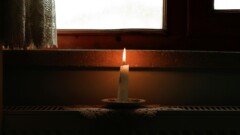A few hours from now I will be heading downtown for a Good Friday service that will bring together several local congregations and, we hope, hundreds or maybe even over a thousand, Christians. Together we will remember the death of our Lord. Today I found a few choice quotes from Frederick Leahy’s wonderful little book The Cross He Bore (seriously, it’s an amazing book and bears repeated readings).
In this first quote Leahy writes about Satan’s hour.
Initially the plans of his enemies would succeed, not just because they came to him under cover of darkness, but essentially because in this hour Satan and his forces were permitted by God to subject Christ to further suffering and humiliation. God reserved this hour for Satan. In all of time this hour was especially his. The darkness of which Christ spoke was the darkness of evil and of the prince of darkness. In this dread hour Satan had free rein. In the case of Job God set a limit to Satan’s activity. In the experience of Christ there were no limits to Satan’s onslaught. He was free to do his worst, and he did.
Gethsemane and Calvary marked high noon in the world’s long day, and God’s permission was absolute as Satan mustered his legions for the decisive encounter. The first Adam had been easy prey. How would he fare with this Adam? As Satan entered the battlefield he did so fully conscious of the Word of God: “He shall bruise your head, and you shall bruise his heel.” Did he recall his cynical contempt for God’s Word earlier when he asked, “Did God actually say…?” (Gen. 3:1). Or did he fear the sentence passed in Eden? Doubtless he did. But the hour was fixed. It was decreed by God. When tempting Christ in the wilderness, Satan had done his utmost to deflect him from this hour, to take some other road than the way of the cross, but all in vain. Now the battle had commenced in earnest. Nothing could stop it. This is your hour, Satan!
And in this second quote he writes about the Lamb who was silent before his accusers:
Christ remained silent about the hidden things. He left his judges with the Word of God and there lay their great responsibility. They must busy themselves with the things that had been revealed. Christ will take his riddle with him to the grave. The meaning will become apparent in due course. He will not cast his pearls before swine, rather he will leave it to his judges to execute their high office before God. In this he did justice to them and at the same time condemned them.
To have explained the riddle to the Sanhedrin would not have been to the glory of God or for the good of Christ’s judges. Imagine what would have happened had he said, “Bury me and within three days I will rise again.” He would have been regarded as an ostentatious and supernatural escapologist! He would have relieved the Sanhedrin of its moral responsibility. The dawn of the New Testament Sabbath would have become the occasion for a gathering of gawping spectators hoping to see the latest wonder. What a mockery of predestination that would have been! And what a windfall for Satan! Christ the redeemer reduced to a mere super-fakir, not lying on a bad of nails or walking on hot coals, but rising from the grave!
If Christ had explained his riddle that day, it would have been a most untimely word. That he would never do. He would not prostitute his God-given mission. All his miracles, including his resurrection, were essentially part of his kingdom and of his redeeming work. They were totally different from those related in the Apocryphal Gospels, as when it is written that the boy Jesus making clay birds with other children made his birds fly! But Christ was no magician; he had neither need nor place for stunts.
All too often Christ’s silence has been given a dangerous one-sidedness, as his passive obedience is stressed almost, if not altogether, to the exclusion of his active obedience. Christ’s silence was deliberate, emphatic and authoritative; it was his deed. The passivity of his suffering was real, but so was the activity of his obedience. Led as a lamb to the slaughter and like a sheep before the shearers, he was active right up to and on the cross. He went as a king to die.
There are just two small dimensions of Christ’s crucifixion for you to ponder today.









